Report on Bullying: Strategies for Nurses and Midwives in Australia
VerifiedAdded on 2019/10/30
|6
|1202
|227
Report
AI Summary
This report focuses on workplace bullying faced by nurses and midwives in clinical settings. It highlights the negative impacts of bullying and emphasizes the need for practical methods to address and prevent it. The report outlines key strategies such as communication with supervisors, understanding legal rights, and building resilience. It also covers identifying bullying behaviors, implementing prevention policies, and fostering a zero-tolerance environment. The report references relevant literature and authorities like the Fair Work Commission and the Australian Human Rights Commission, providing a comprehensive overview of the issue and potential solutions. It stresses the importance of empowering nurses, promoting collaboration, and ensuring a safe working environment.
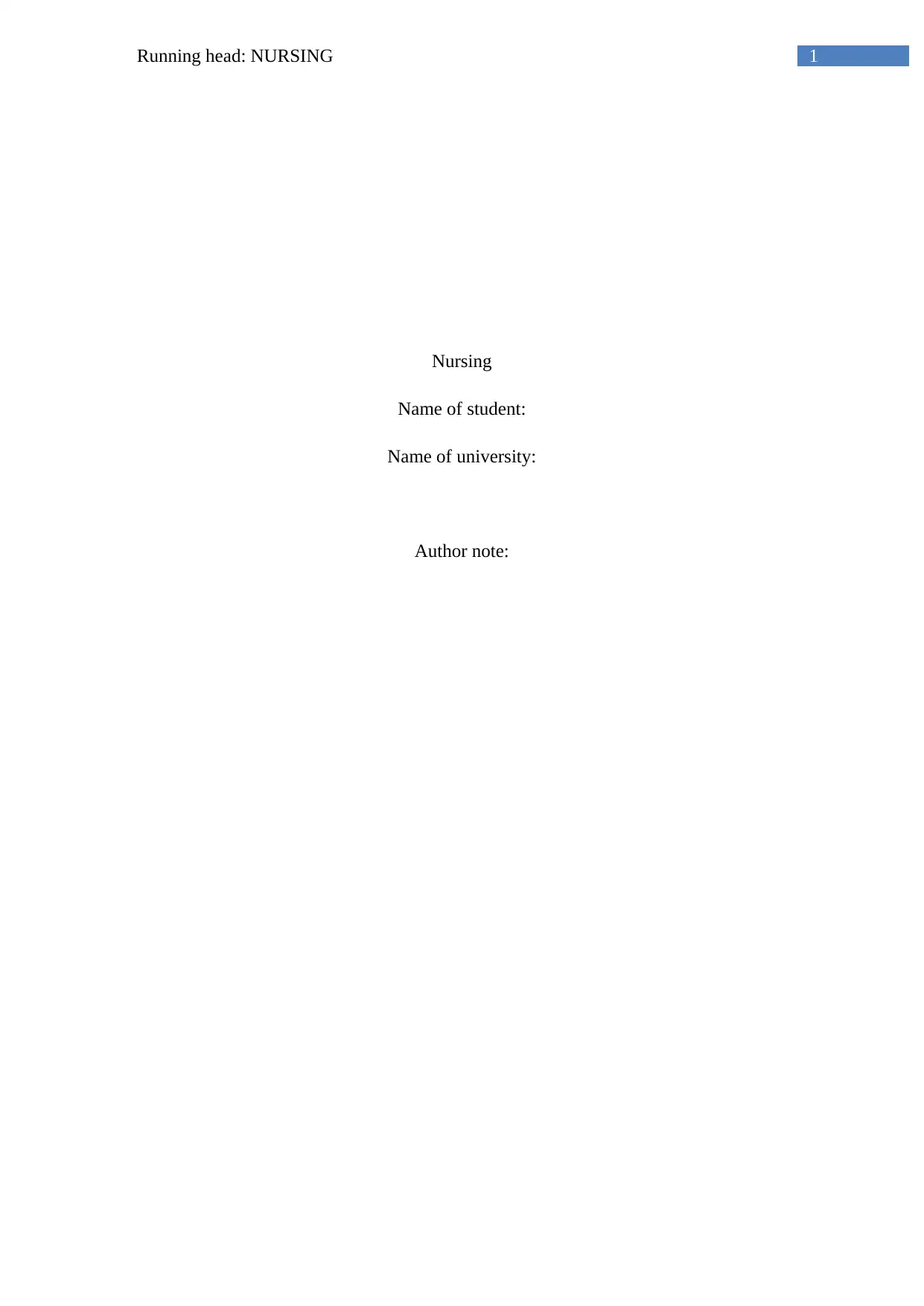
1Running head: NURSING
Nursing
Name of student:
Name of university:
Author note:
Nursing
Name of student:
Name of university:
Author note:
Paraphrase This Document
Need a fresh take? Get an instant paraphrase of this document with our AI Paraphraser
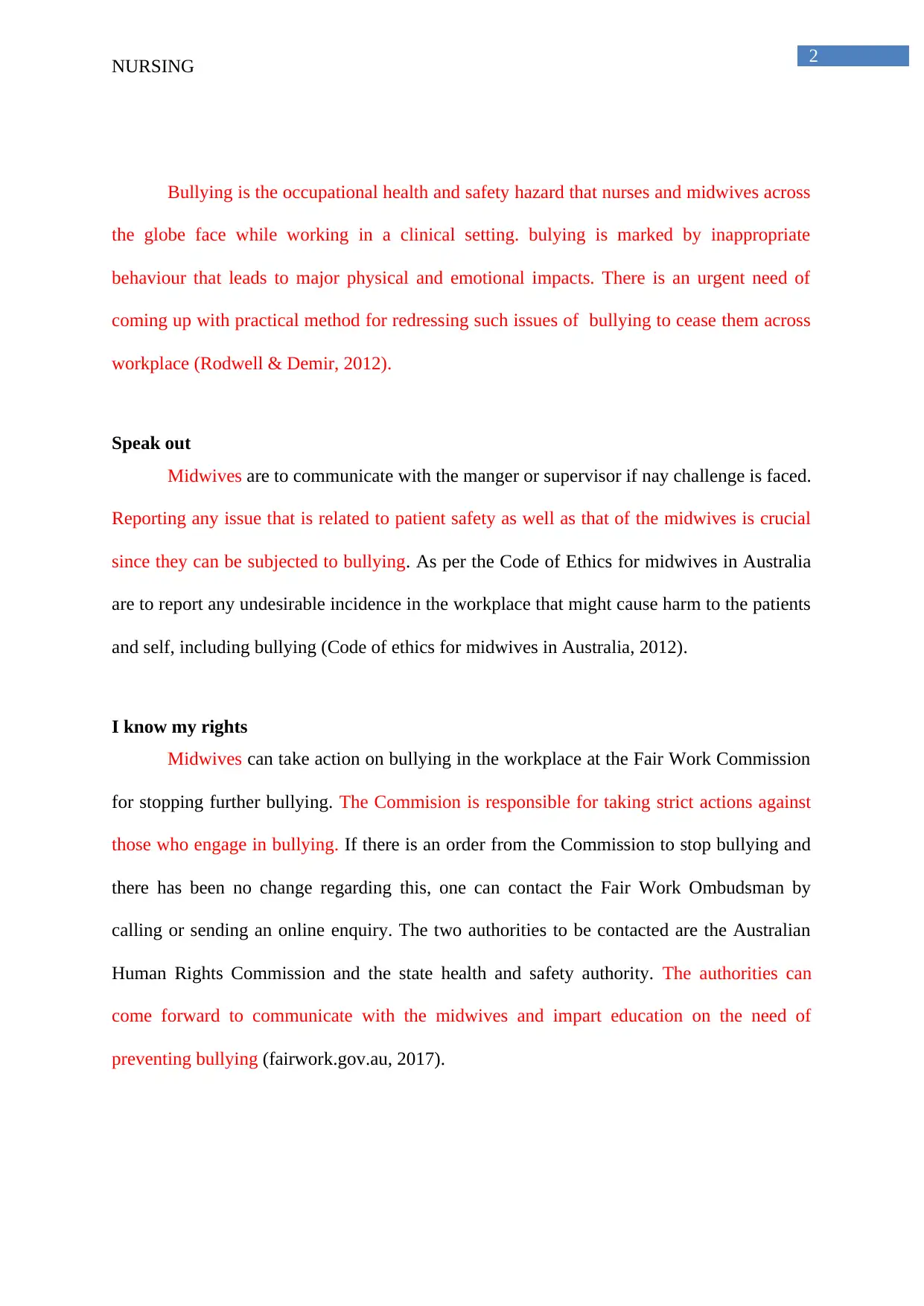
2
NURSING
Bullying is the occupational health and safety hazard that nurses and midwives across
the globe face while working in a clinical setting. bulying is marked by inappropriate
behaviour that leads to major physical and emotional impacts. There is an urgent need of
coming up with practical method for redressing such issues of bullying to cease them across
workplace (Rodwell & Demir, 2012).
Speak out
Midwives are to communicate with the manger or supervisor if nay challenge is faced.
Reporting any issue that is related to patient safety as well as that of the midwives is crucial
since they can be subjected to bullying. As per the Code of Ethics for midwives in Australia
are to report any undesirable incidence in the workplace that might cause harm to the patients
and self, including bullying (Code of ethics for midwives in Australia, 2012).
I know my rights
Midwives can take action on bullying in the workplace at the Fair Work Commission
for stopping further bullying. The Commision is responsible for taking strict actions against
those who engage in bullying. If there is an order from the Commission to stop bullying and
there has been no change regarding this, one can contact the Fair Work Ombudsman by
calling or sending an online enquiry. The two authorities to be contacted are the Australian
Human Rights Commission and the state health and safety authority. The authorities can
come forward to communicate with the midwives and impart education on the need of
preventing bullying (fairwork.gov.au, 2017).
NURSING
Bullying is the occupational health and safety hazard that nurses and midwives across
the globe face while working in a clinical setting. bulying is marked by inappropriate
behaviour that leads to major physical and emotional impacts. There is an urgent need of
coming up with practical method for redressing such issues of bullying to cease them across
workplace (Rodwell & Demir, 2012).
Speak out
Midwives are to communicate with the manger or supervisor if nay challenge is faced.
Reporting any issue that is related to patient safety as well as that of the midwives is crucial
since they can be subjected to bullying. As per the Code of Ethics for midwives in Australia
are to report any undesirable incidence in the workplace that might cause harm to the patients
and self, including bullying (Code of ethics for midwives in Australia, 2012).
I know my rights
Midwives can take action on bullying in the workplace at the Fair Work Commission
for stopping further bullying. The Commision is responsible for taking strict actions against
those who engage in bullying. If there is an order from the Commission to stop bullying and
there has been no change regarding this, one can contact the Fair Work Ombudsman by
calling or sending an online enquiry. The two authorities to be contacted are the Australian
Human Rights Commission and the state health and safety authority. The authorities can
come forward to communicate with the midwives and impart education on the need of
preventing bullying (fairwork.gov.au, 2017).
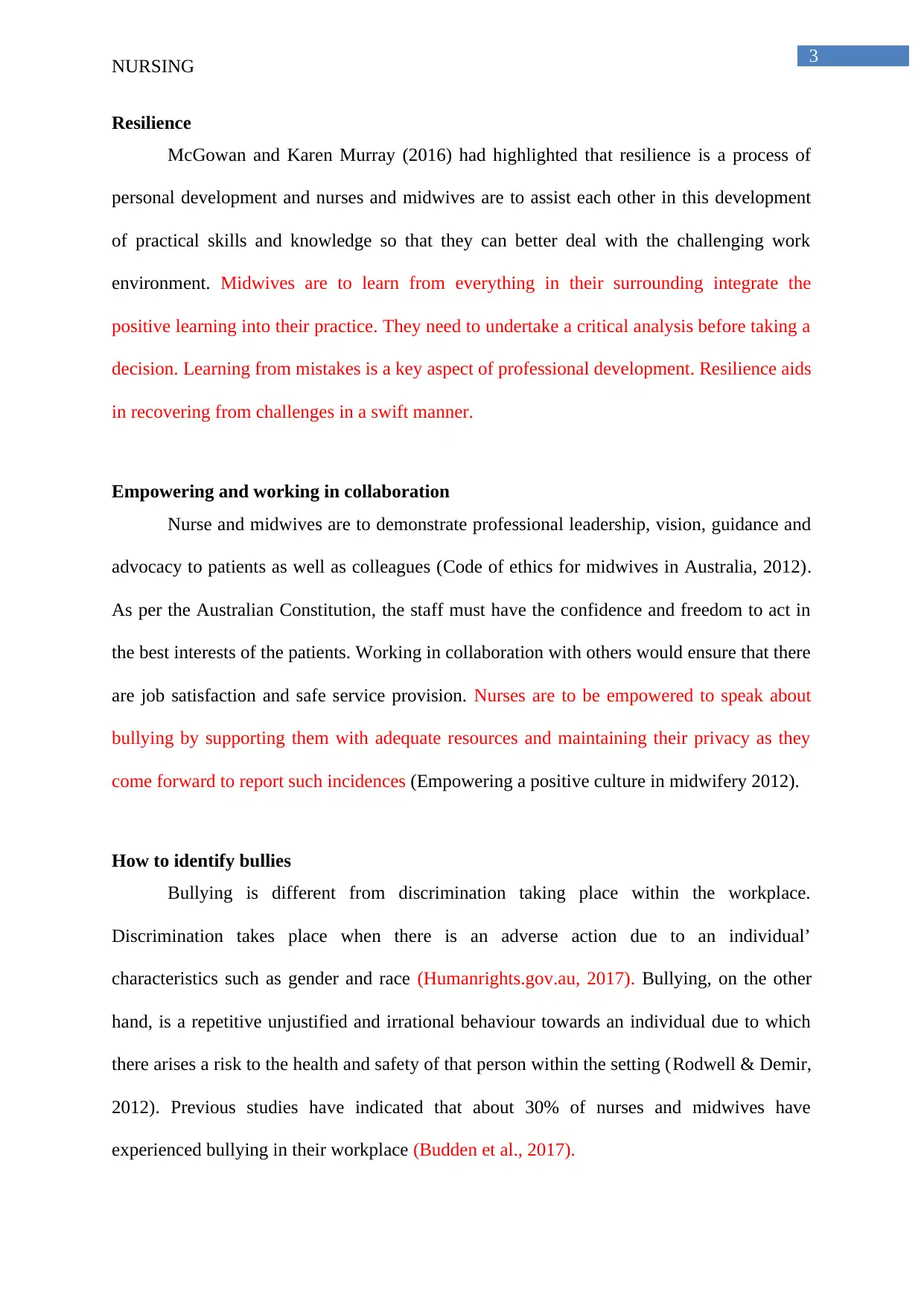
3
NURSING
Resilience
McGowan and Karen Murray (2016) had highlighted that resilience is a process of
personal development and nurses and midwives are to assist each other in this development
of practical skills and knowledge so that they can better deal with the challenging work
environment. Midwives are to learn from everything in their surrounding integrate the
positive learning into their practice. They need to undertake a critical analysis before taking a
decision. Learning from mistakes is a key aspect of professional development. Resilience aids
in recovering from challenges in a swift manner.
Empowering and working in collaboration
Nurse and midwives are to demonstrate professional leadership, vision, guidance and
advocacy to patients as well as colleagues (Code of ethics for midwives in Australia, 2012).
As per the Australian Constitution, the staff must have the confidence and freedom to act in
the best interests of the patients. Working in collaboration with others would ensure that there
are job satisfaction and safe service provision. Nurses are to be empowered to speak about
bullying by supporting them with adequate resources and maintaining their privacy as they
come forward to report such incidences (Empowering a positive culture in midwifery 2012).
How to identify bullies
Bullying is different from discrimination taking place within the workplace.
Discrimination takes place when there is an adverse action due to an individual’
characteristics such as gender and race (Humanrights.gov.au, 2017). Bullying, on the other
hand, is a repetitive unjustified and irrational behaviour towards an individual due to which
there arises a risk to the health and safety of that person within the setting (Rodwell & Demir,
2012). Previous studies have indicated that about 30% of nurses and midwives have
experienced bullying in their workplace (Budden et al., 2017).
NURSING
Resilience
McGowan and Karen Murray (2016) had highlighted that resilience is a process of
personal development and nurses and midwives are to assist each other in this development
of practical skills and knowledge so that they can better deal with the challenging work
environment. Midwives are to learn from everything in their surrounding integrate the
positive learning into their practice. They need to undertake a critical analysis before taking a
decision. Learning from mistakes is a key aspect of professional development. Resilience aids
in recovering from challenges in a swift manner.
Empowering and working in collaboration
Nurse and midwives are to demonstrate professional leadership, vision, guidance and
advocacy to patients as well as colleagues (Code of ethics for midwives in Australia, 2012).
As per the Australian Constitution, the staff must have the confidence and freedom to act in
the best interests of the patients. Working in collaboration with others would ensure that there
are job satisfaction and safe service provision. Nurses are to be empowered to speak about
bullying by supporting them with adequate resources and maintaining their privacy as they
come forward to report such incidences (Empowering a positive culture in midwifery 2012).
How to identify bullies
Bullying is different from discrimination taking place within the workplace.
Discrimination takes place when there is an adverse action due to an individual’
characteristics such as gender and race (Humanrights.gov.au, 2017). Bullying, on the other
hand, is a repetitive unjustified and irrational behaviour towards an individual due to which
there arises a risk to the health and safety of that person within the setting (Rodwell & Demir,
2012). Previous studies have indicated that about 30% of nurses and midwives have
experienced bullying in their workplace (Budden et al., 2017).
⊘ This is a preview!⊘
Do you want full access?
Subscribe today to unlock all pages.

Trusted by 1+ million students worldwide
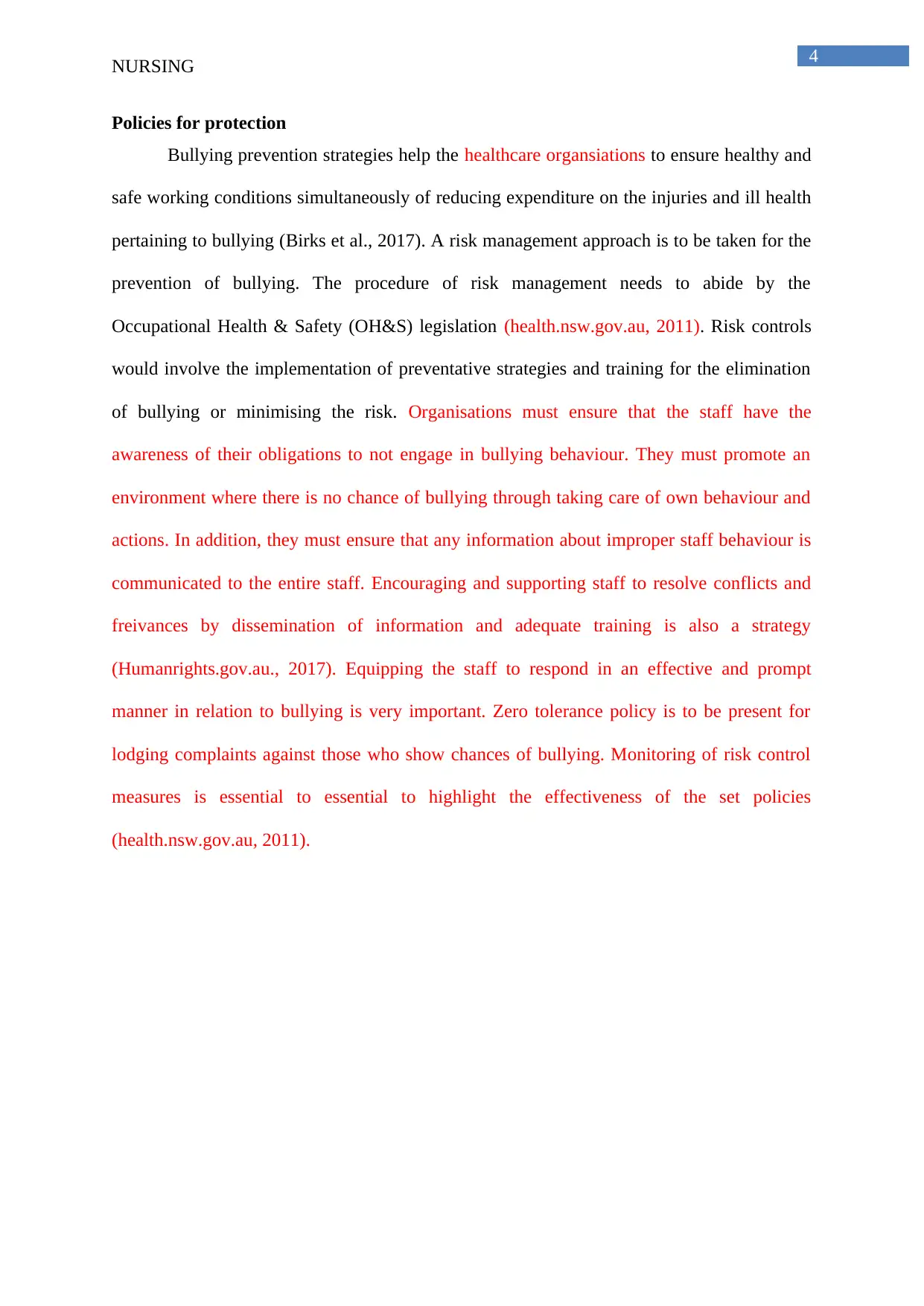
4
NURSING
Policies for protection
Bullying prevention strategies help the healthcare organsiations to ensure healthy and
safe working conditions simultaneously of reducing expenditure on the injuries and ill health
pertaining to bullying (Birks et al., 2017). A risk management approach is to be taken for the
prevention of bullying. The procedure of risk management needs to abide by the
Occupational Health & Safety (OH&S) legislation (health.nsw.gov.au, 2011). Risk controls
would involve the implementation of preventative strategies and training for the elimination
of bullying or minimising the risk. Organisations must ensure that the staff have the
awareness of their obligations to not engage in bullying behaviour. They must promote an
environment where there is no chance of bullying through taking care of own behaviour and
actions. In addition, they must ensure that any information about improper staff behaviour is
communicated to the entire staff. Encouraging and supporting staff to resolve conflicts and
freivances by dissemination of information and adequate training is also a strategy
(Humanrights.gov.au., 2017). Equipping the staff to respond in an effective and prompt
manner in relation to bullying is very important. Zero tolerance policy is to be present for
lodging complaints against those who show chances of bullying. Monitoring of risk control
measures is essential to essential to highlight the effectiveness of the set policies
(health.nsw.gov.au, 2011).
NURSING
Policies for protection
Bullying prevention strategies help the healthcare organsiations to ensure healthy and
safe working conditions simultaneously of reducing expenditure on the injuries and ill health
pertaining to bullying (Birks et al., 2017). A risk management approach is to be taken for the
prevention of bullying. The procedure of risk management needs to abide by the
Occupational Health & Safety (OH&S) legislation (health.nsw.gov.au, 2011). Risk controls
would involve the implementation of preventative strategies and training for the elimination
of bullying or minimising the risk. Organisations must ensure that the staff have the
awareness of their obligations to not engage in bullying behaviour. They must promote an
environment where there is no chance of bullying through taking care of own behaviour and
actions. In addition, they must ensure that any information about improper staff behaviour is
communicated to the entire staff. Encouraging and supporting staff to resolve conflicts and
freivances by dissemination of information and adequate training is also a strategy
(Humanrights.gov.au., 2017). Equipping the staff to respond in an effective and prompt
manner in relation to bullying is very important. Zero tolerance policy is to be present for
lodging complaints against those who show chances of bullying. Monitoring of risk control
measures is essential to essential to highlight the effectiveness of the set policies
(health.nsw.gov.au, 2011).
Paraphrase This Document
Need a fresh take? Get an instant paraphrase of this document with our AI Paraphraser
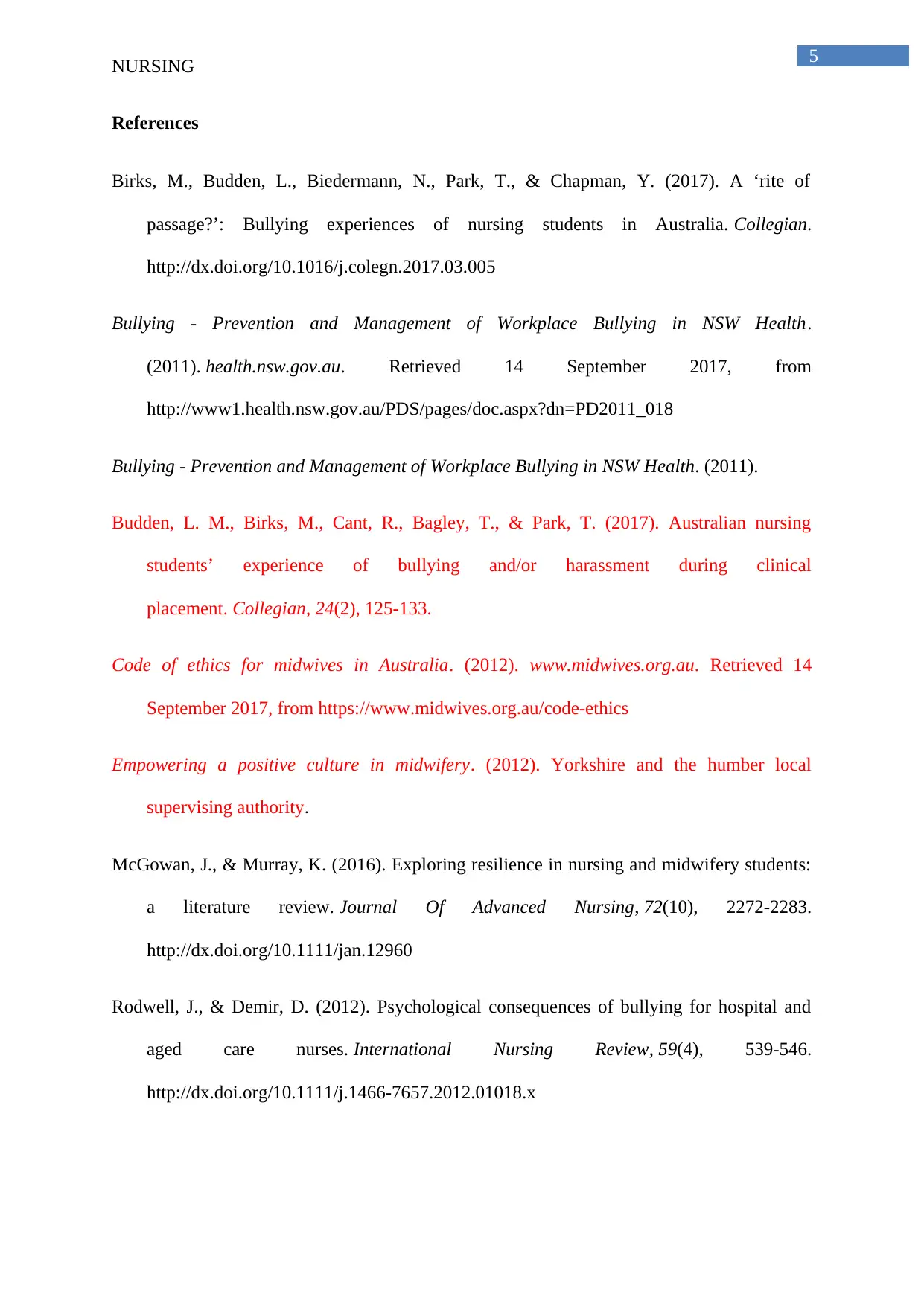
5
NURSING
References
Birks, M., Budden, L., Biedermann, N., Park, T., & Chapman, Y. (2017). A ‘rite of
passage?’: Bullying experiences of nursing students in Australia. Collegian.
http://dx.doi.org/10.1016/j.colegn.2017.03.005
Bullying - Prevention and Management of Workplace Bullying in NSW Health.
(2011). health.nsw.gov.au. Retrieved 14 September 2017, from
http://www1.health.nsw.gov.au/PDS/pages/doc.aspx?dn=PD2011_018
Bullying - Prevention and Management of Workplace Bullying in NSW Health. (2011).
Budden, L. M., Birks, M., Cant, R., Bagley, T., & Park, T. (2017). Australian nursing
students’ experience of bullying and/or harassment during clinical
placement. Collegian, 24(2), 125-133.
Code of ethics for midwives in Australia. (2012). www.midwives.org.au. Retrieved 14
September 2017, from https://www.midwives.org.au/code-ethics
Empowering a positive culture in midwifery. (2012). Yorkshire and the humber local
supervising authority.
McGowan, J., & Murray, K. (2016). Exploring resilience in nursing and midwifery students:
a literature review. Journal Of Advanced Nursing, 72(10), 2272-2283.
http://dx.doi.org/10.1111/jan.12960
Rodwell, J., & Demir, D. (2012). Psychological consequences of bullying for hospital and
aged care nurses. International Nursing Review, 59(4), 539-546.
http://dx.doi.org/10.1111/j.1466-7657.2012.01018.x
NURSING
References
Birks, M., Budden, L., Biedermann, N., Park, T., & Chapman, Y. (2017). A ‘rite of
passage?’: Bullying experiences of nursing students in Australia. Collegian.
http://dx.doi.org/10.1016/j.colegn.2017.03.005
Bullying - Prevention and Management of Workplace Bullying in NSW Health.
(2011). health.nsw.gov.au. Retrieved 14 September 2017, from
http://www1.health.nsw.gov.au/PDS/pages/doc.aspx?dn=PD2011_018
Bullying - Prevention and Management of Workplace Bullying in NSW Health. (2011).
Budden, L. M., Birks, M., Cant, R., Bagley, T., & Park, T. (2017). Australian nursing
students’ experience of bullying and/or harassment during clinical
placement. Collegian, 24(2), 125-133.
Code of ethics for midwives in Australia. (2012). www.midwives.org.au. Retrieved 14
September 2017, from https://www.midwives.org.au/code-ethics
Empowering a positive culture in midwifery. (2012). Yorkshire and the humber local
supervising authority.
McGowan, J., & Murray, K. (2016). Exploring resilience in nursing and midwifery students:
a literature review. Journal Of Advanced Nursing, 72(10), 2272-2283.
http://dx.doi.org/10.1111/jan.12960
Rodwell, J., & Demir, D. (2012). Psychological consequences of bullying for hospital and
aged care nurses. International Nursing Review, 59(4), 539-546.
http://dx.doi.org/10.1111/j.1466-7657.2012.01018.x
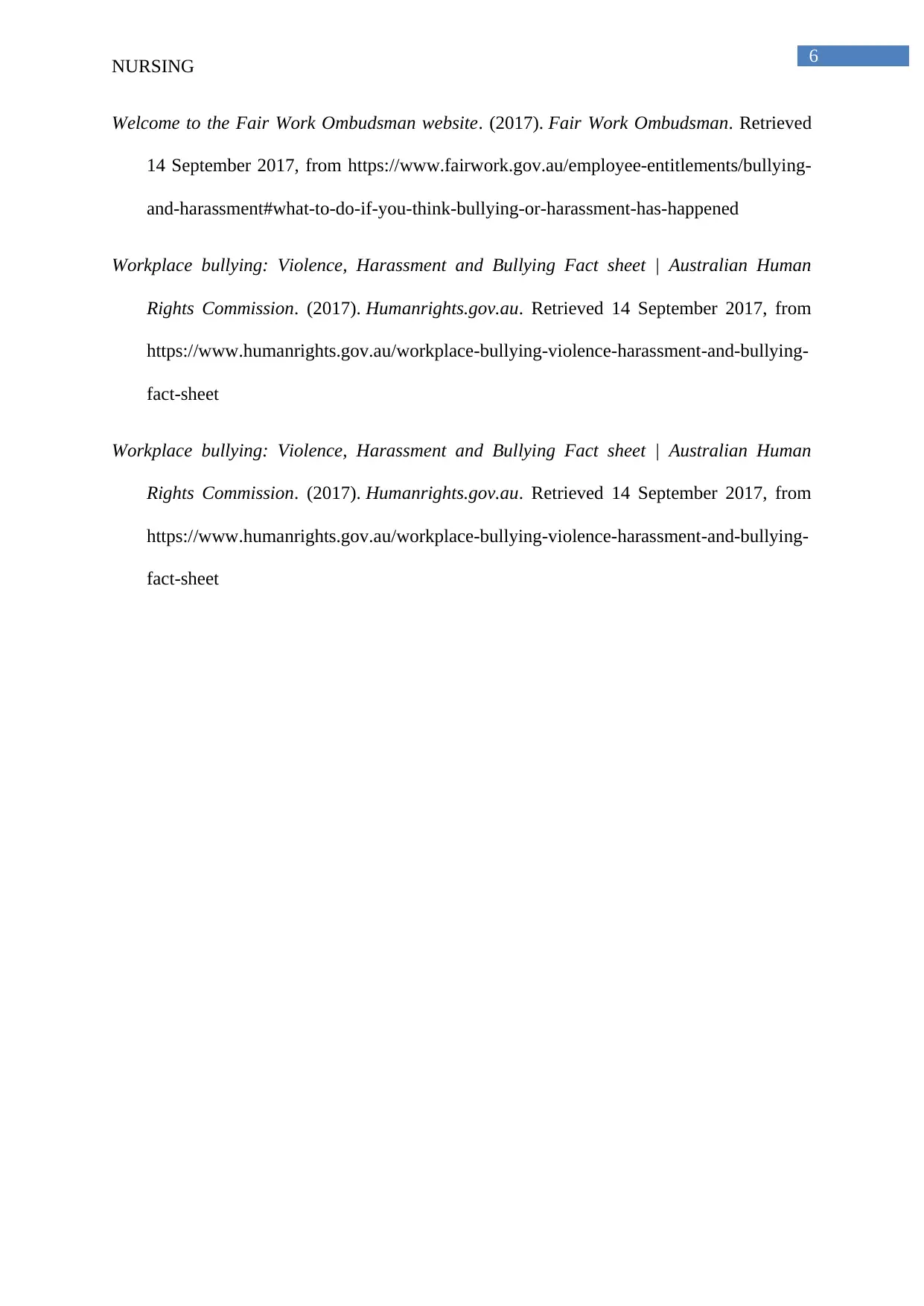
6
NURSING
Welcome to the Fair Work Ombudsman website. (2017). Fair Work Ombudsman. Retrieved
14 September 2017, from https://www.fairwork.gov.au/employee-entitlements/bullying-
and-harassment#what-to-do-if-you-think-bullying-or-harassment-has-happened
Workplace bullying: Violence, Harassment and Bullying Fact sheet | Australian Human
Rights Commission. (2017). Humanrights.gov.au. Retrieved 14 September 2017, from
https://www.humanrights.gov.au/workplace-bullying-violence-harassment-and-bullying-
fact-sheet
Workplace bullying: Violence, Harassment and Bullying Fact sheet | Australian Human
Rights Commission. (2017). Humanrights.gov.au. Retrieved 14 September 2017, from
https://www.humanrights.gov.au/workplace-bullying-violence-harassment-and-bullying-
fact-sheet
NURSING
Welcome to the Fair Work Ombudsman website. (2017). Fair Work Ombudsman. Retrieved
14 September 2017, from https://www.fairwork.gov.au/employee-entitlements/bullying-
and-harassment#what-to-do-if-you-think-bullying-or-harassment-has-happened
Workplace bullying: Violence, Harassment and Bullying Fact sheet | Australian Human
Rights Commission. (2017). Humanrights.gov.au. Retrieved 14 September 2017, from
https://www.humanrights.gov.au/workplace-bullying-violence-harassment-and-bullying-
fact-sheet
Workplace bullying: Violence, Harassment and Bullying Fact sheet | Australian Human
Rights Commission. (2017). Humanrights.gov.au. Retrieved 14 September 2017, from
https://www.humanrights.gov.au/workplace-bullying-violence-harassment-and-bullying-
fact-sheet
⊘ This is a preview!⊘
Do you want full access?
Subscribe today to unlock all pages.

Trusted by 1+ million students worldwide
1 out of 6
Your All-in-One AI-Powered Toolkit for Academic Success.
+13062052269
info@desklib.com
Available 24*7 on WhatsApp / Email
![[object Object]](/_next/static/media/star-bottom.7253800d.svg)
Unlock your academic potential
Copyright © 2020–2025 A2Z Services. All Rights Reserved. Developed and managed by ZUCOL.


